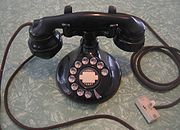
Model 102 telephone
Encyclopedia

Western Electric
Western Electric Company was an American electrical engineering company, the manufacturing arm of AT&T from 1881 to 1995. It was the scene of a number of technological innovations and also some seminal developments in industrial management...
first widely distributed telephone set to feature the transmitter and receiver in a common handset. Prior models had been of the "candlestick" type, which featured a transmitter fixed to the base, and a receiver held to the ear. The 102 was manufactured between 1927 and 1929.
As early as 1890, Western Electric had been experimenting with single handset models, but two technical problems prevented them from being widely produced at that time. First, the transmitters of the day did not work well unless oriented in a vertical plane. If moved to other angles, as would be expected in a single handset, carbon granules in the transmitter would move around, resulting in poor voice quality, referred to as "carbon noise".
The second hurdle to a common handset model was that audio from the receiver, known as sidetone
Sidetone
Sidetone is audible feedback to someone who is speaking. The term is most used in telecommunication contexts.-Telephony:In telephony, sidetone is the effect of sound that is picked up by the telephone's mouthpiece and in real-time introduced at a low level into the earpiece of the same handset,...
, would be picked up by the transmitter and amplified, resulting in a squealing noise fed back through the receiver (acoustic feedback). This problem was made worse by the signal boosting circuitry used in the subset which resulted in a much stronger signal at the receiver, as well as the hollow handsets which provided an internal channel for the audio to reach the transmitter.
In the 1920s, developments in anti-sidetone circuitry and non-positional transmitters (which would work in any orientation) led Western Electric to move forward with developing a handset model which would be free of both of these problems. The result was the E1 handset, which was ready for mass production in 1927. This handset was paired with the A-Type base, essentially a cut-down candlestick with a cradle for the handset, and released in a limited capacity as Western Electric's first handset subscriber set, the Model A1.
Although the E1 handset was built to accommodate the anti-sidetone circuitry, such circuitry was still not ready by the time the E1/A desk set was ready. However, the solid bakelite construction of the handset suppressed the sidetone feedback to acceptable levels.
As work continued on the anti-sidetone circuitry, a new base was produced for the E1 handset to replace the cut-down candlestick, and to allow mass production of the set. The new base was designated B1, and was similar in appearance to the A base, but with more flowing lines and a shell cast as one piece.
This is the combination that would later receive the designation "Model 102". During the model's production life, however, it was just referred to by its component parts. It was not until the Model 202 in 1930 that Western Electric began assigning assembly codes to its subscriber sets.
Originally, these codes just referred to the electrical capabilities of the sets, with 102 being the full sidetone set, and 202 containing the anti-sidetone circuitry. Thus, some of the next base models, the oval D1 bases, would still be designated as Model 102 if they did not yet have the anti-sidetone circuitry.
Like its predecessors and competitors, the Model 102 contained no ringer or induction coils. These were contained in an external subset (ringer box) that connected between the phone and the wall.
External links
- Western Electric Telephone Models — A look at the evolution of the Western Electric's dial telephones

